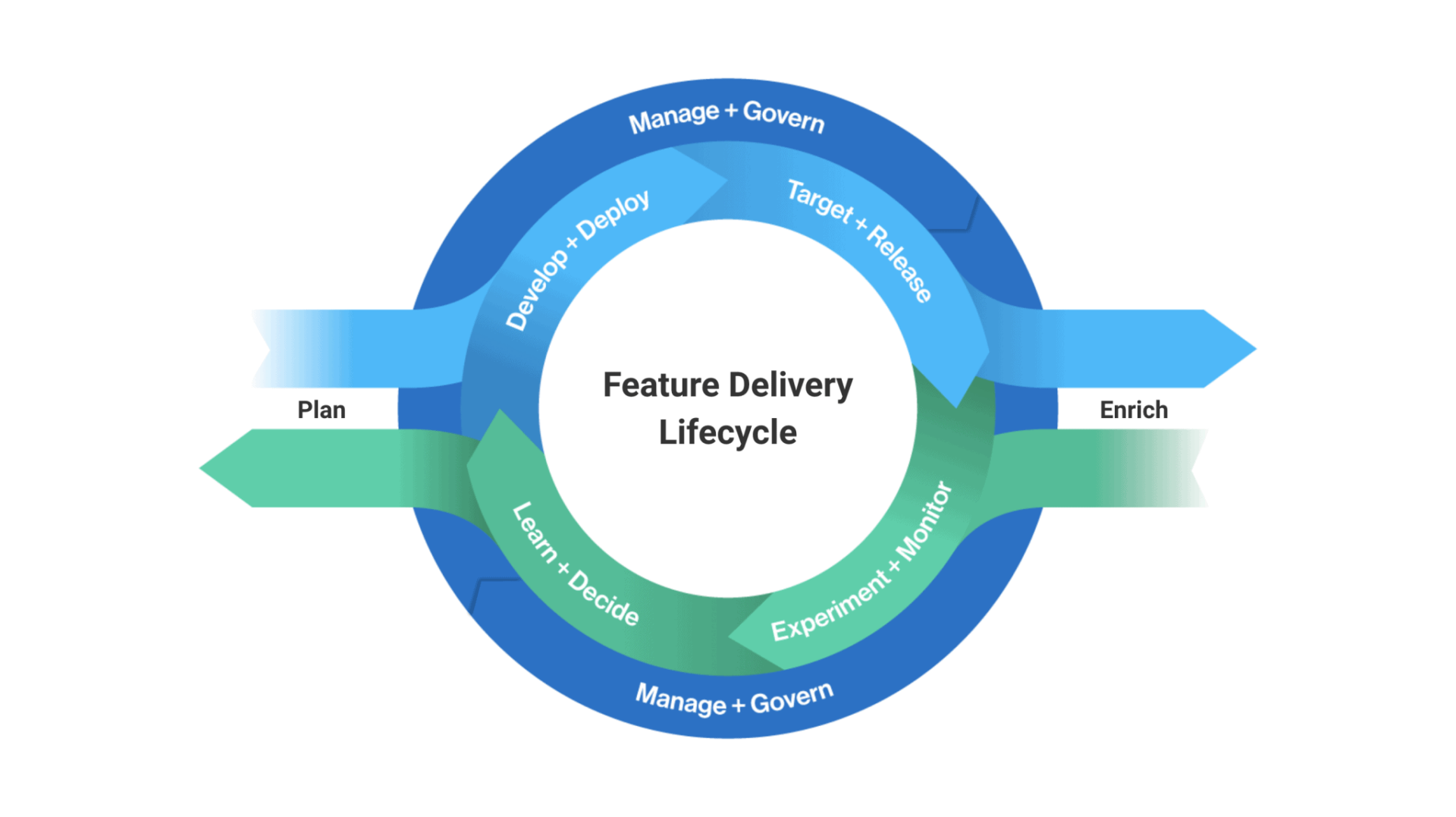We meet enterprises every day that are in various stages of modernizing their software development technologies and processes. Whether they’re in the middle of adopting agile and DevOps best practices, building a culture of experimentation, or both, they all share the same goal: to safely and rapidly deliver products that keep pace with evolving customer needs and maintain a competitive edge in the market.
These enterprises choose Split for an accelerated path to success using feature flags to increase development speed and release safety, and experimentation to measure and maximize business impact. At Split, we call this path the Feature Delivery Lifecycle. Below we outline how the lifecycle enables engineering and product teams to beat their competitors to market with innovative products that delight their customers and propel their business forward.

Feature Flags for Optimizing Speed and Control
The top half of the Feature Delivery Lifecycle focuses on increasing development speed and release safety. Software development teams in this stage are no stranger to chaotic release nights, painful rollbacks, and lengthy delivery delays. Feature flags can dramatically reduce cycle time and release risk by enabling progressive delivery, trunk-based development, and testing in production.
Split’s feature flagging capabilities allow engineering and product teams to:
Plan
- Coordinate projects and rollouts. Integrate feature flags with existing issue tracking and project management tools when planning new features and experiments.
Develop + Deploy
- Separate code deploy from release. Gate code changes behind feature flags to deploy at any time without disrupting the user experience.
- Scale feature flags across teams. Create and manage feature flags within an intuitive UI supported by all major languages.
Target + Release
- Minimize the blast radius of releases. Control when, which, and how many users are exposed to each code change to limit the damage of potential bugs.
- Ensure data privacy. Target users by private attributes without requiring sensitive data to leave internal systems.
Experimentation for Maximized Business Impact
Optimizing release cadence and safety frees software development teams to direct their attention to the bottom half of the lifecycle: maximizing feature impact. With the worst of merge hell far behind them, they evolve from asking “is this feature working?” to “is this feature working for the business?” They start using feature flags to run experiments and seek answers in data.
Split’s monitoring and experimentation combine feature flags and data to allow engineering and product teams to:
Enrich
- Leverage existing data. Integrate with customer data platforms, data warehouses, and product analytics tools to transform data into actionable insights.
Experiment + Monitor
- Test out new ideas. Run A/B and multivariant tests on frontend, backend, and mobile features to measure and compare their impact on the customer experience and business objectives.
- Monitor feature health. Measure the causal effect of each feature to identify and instantly stop the root cause of performance degradations with the killswitch.
- Ensure statistical rigor. Adhere to experimentation best practices for statistically significant results with absent or limited data science expertise.
Learn + Decide
- Ensure fast and complete results. Calculate every metric for every feature to catch unintended consequences. Add metrics during or after an experiment without having to restart.
- Make data-driven product decisions. Review metrics results to determine whether to continue the lifecycle with a new iteration or end the lifecycle by rolling out or retiring the feature for 100% of users.
- Dynamically iterate in production. Allow non-technical team members to change flag behavior in production without relying on engineers each time.
Feature Delivery at Enterprise Scale
Encompassing the entire lifecycle is Manage + Govern, which allows software development teams to scale their users, feature flags, and change requests while ensuring enterprise-grade security and compliance.
Manage + Govern
- Manage user permissions. Control which users can edit or publish changes by setting permissions for specific objects or environments.
- Ensure compliance. Request peer review and approval before code changes in production take effect. Track user actions with audit logs.
- Maximize security. Protect your data with SSL encryption, SSO, session timeouts, and forced logouts.
The Feature Delivery Platform: Unified Feature Flagging and Experimentation
Split seamlessly unifies these capabilities into a single platform, making it easy for software development teams to master the Feature Delivery Lifecycle for optimal speed, safety, and business impact. Get started on Split for free at split.io/signup/
To learn more about innovations we’re adding this year to enhance the Feature Delivery Lifecycle, watch our product keynote from Flagship 21. As always, follow us on Twitter @splitsoftware and subscribe to our YouTube channel to stay in the loop!
Get Split Certified
Split Arcade includes product explainer videos, clickable product tutorials, manipulatable code examples, and interactive challenges.
Switch It On With Split
The Split Feature Data Platform™ gives you the confidence to move fast without breaking things. Set up feature flags and safely deploy to production, controlling who sees which features and when. Connect every flag to contextual data, so you can know if your features are making things better or worse and act without hesitation. Effortlessly conduct feature experiments like A/B tests without slowing down. Whether you’re looking to increase your releases, to decrease your MTTR, or to ignite your dev team without burning them out–Split is both a feature management platform and partnership to revolutionize the way the work gets done. Switch on a free account today, schedule a demo, or contact us for further questions.
